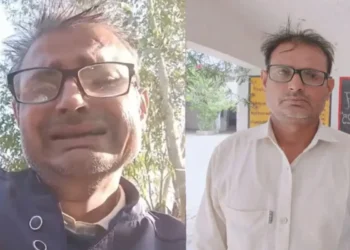With all seven vacant cabinet seats going to BJP nominees, the party’s strategic focus on EBCs, including a Kurmi pick from Nitish’s own caste, hints at a post-election power play in Bihar’s NDA alliance.
BY Navin Upadhyay
On February 26, 2025, the Bihar cabinet underwent a significant expansion at Raj Bhavan, with Chief Minister Nitish Kumar presiding over the induction of seven new ministers—all from the Bharatiya Janata Party (BJP). This move, coming months ahead of the anticipated assembly elections, sends an unmistakable message: the BJP is aggressively expanding its caste base, potentially at the expense of its ally, Nitish Kumar’s Janata Dal (United).
While Nitish remains the undisputed leader of the Extremely Backward Classes (EBC) coalition—a key demographic in Bihar’s caste-driven politics—the BJP has now positioned itself to challenge this dominance by inducting four EBC ministers, including one from Nitish’s own Kurmi caste. This strategic maneuver could unsettle the JD(U) rank and file, raising questions about Nitish’s long-term vision for his party, especially given his reportedly declining health.
The New Ministers: A Caste Breakdown
The seven BJP ministers sworn in today reflect a deliberate attempt to broaden the party’s appeal across Bihar’s diverse caste spectrum. Here’s a detailed look at the inductees and their caste identities:
-
Rakesh Singh (Rajput) – A prominent upper-caste leader from north Bihar, Singh’s inclusion reinforces BJP’s hold over the Rajput community, a traditional vote bank for the party.
-
Manoj Sharma (Bhumihar) – Another upper-caste pick, Sharma hails from the Bhumihar community, signaling BJP’s intent to consolidate its influence among forward castes.
-
Santosh Yadav (Kurmi) – The most striking appointment, Yadav belongs to Nitish Kumar’s own Kurmi caste—an EBC group that has long been the JD(U) chief’s bedrock. His induction is a bold move by the BJP to encroach on Nitish’s core constituency.
-
Ramesh Sah (Teli) – Representing the Teli community, an EBC group, Sah’s inclusion underscores BJP’s focus on micro-caste outreach within the EBC bloc.
-
Kailash Paswan (Kevat) – From the Kevat community, another EBC caste, Paswan’s appointment further diversifies BJP’s EBC representation.
-
Sunita Devi (Kushwaha) – A member of the Kushwaha caste, classified under the EBC umbrella, Devi’s induction strengthens BJP’s appeal among this influential group.
-
Arvind Gupta (Vaishya) – Representing the trading Vaishya community, Gupta rounds out the list, ensuring BJP’s outreach extends to the economically significant Baniya voters.
This caste composition—four EBCs, two upper castes, and one from the Vaishya community—demonstrates a calculated effort by the BJP to widen its social coalition while making significant inroads into the EBC vote bank, traditionally a JD(U) stronghold.
BJP’s EBC Push: A Challenge to Nitish’s Legacy
‘
Nitish Kumar has long been the architect of Bihar’s EBC political awakening, skillfully weaving a coalition of smaller, marginalized castes into a formidable electoral force. His leadership has rested on this delicate balance, supplemented by his personal appeal as a Kurmi leader. However, the BJP’s decision to induct four EBC ministers, including Santosh Yadav from the Kurmi caste, suggests a deliberate attempt to dilute Nitish’s monopoly over this demographic. The inclusion of a Kurmi minister from the BJP quota is particularly symbolic—it’s a direct signal that the party is no longer content to play second fiddle in the caste game.
There’s little doubt that this cabinet composition was discussed with Nitish Kumar beforehand. As the NDA’s senior partner in Bihar, the BJP would not have proceeded without the Chief Minister’s approval. Yet, this acquiescence raises uncomfortable questions for JD(U) loyalists. If Nitish has permitted the BJP to encroach on his core base, what does it say about his confidence in JD(U)’s future—or his own? Reports of his frail health only amplify these concerns. At 73, Nitish has been a towering figure in Bihar politics for nearly two decades, but his physical condition could limit his ability to lead the NDA into the upcoming elections with the vigor of past campaigns.
The BJP’s Assertion: All Seven Seats Claimed
Perhaps the most telling aspect of this expansion is that all seven vacant cabinet berths went to BJP nominees, with no representation from JD(U). The Bihar cabinet can accommodate up to 36 ministers, and prior to this expansion, it had 23 members, including Nitish and his two deputy chief ministers. The decision to allocate all seven new slots to the BJP speaks volumes about the shifting power dynamics within the NDA. While Nitish remains the alliance’s public face, the BJP is flexing its muscle behind the scenes, leveraging its superior organizational strength and national clout.
This move aligns with the BJP’s broader strategy in Bihar. Despite being the larger partner in terms of assembly seats (74 to JD(U)’s 45 in the 2020 elections), the party has consistently endorsed Nitish as the NDA’s chief ministerial face—a pragmatic concession to his regional stature. Today’s cabinet expansion, however, hints at a more assertive BJP, one that is laying the groundwork to maximize its influence in the state, both pre- and post-election.
Electoral Implications and the Post-Nitish Scenario
There’s broad consensus within the NDA that the BJP will contest the upcoming assembly elections under Nitish Kumar’s leadership. This commitment was reiterated by BJP leaders following the expansion, with state president Dilip Jaiswal (who resigned from his ministerial post to facilitate this reshuffle) emphasizing Nitish’s role as the alliance’s anchor. Yet, the post-election scenario remains murky. Nitish’s health woes introduce an element of uncertainty. Should his condition deteriorate further, the BJP’s enhanced caste outreach—particularly among EBCs—could position it to dictate terms in any succession battle.
For JD(U), the expansion is a double-edged sword. On one hand, it strengthens the NDA’s electoral prospects by broadening its caste appeal. On the other, it risks alienating Nitish’s base, who may perceive the BJP’s EBC push as a betrayal of their leader’s legacy. The Kurmi community, in particular, might resent seeing one of their own donning the BJP’s saffron rather than JD(U)’s green. This unease could ripple through JD(U)’s grassroots, especially if Nitish’s health prevents him from actively countering the BJP’s narrative.
Conclusion: A Balancing Act with High Stakes
The Bihar cabinet expansion of February 26, 2025, is more than a routine political exercise—it’s a window into the evolving dynamics of the NDA in Bihar. The BJP’s induction of seven ministers, with a heavy emphasis on EBC representation, marks a bold bid to reshape the state’s caste arithmetic. Nitish Kumar, by approving this lineup, has signaled a willingness to share his political turf, perhaps out of necessity given his health or a strategic calculation to keep the alliance intact. Yet, this concession could come at a cost to JD(U)’s identity and influence.
As Bihar barrels toward the assembly elections, the BJP’s caste play will be closely watched. For now, Nitish remains the NDA’s undisputed leader, but today’s events suggest that the BJP is preparing for a future where it may not need to lean so heavily on his charisma. Whether this gamble pays off—or sparks a backlash among Bihar’s caste-conscious voters—will only become clear in the months ahead.













